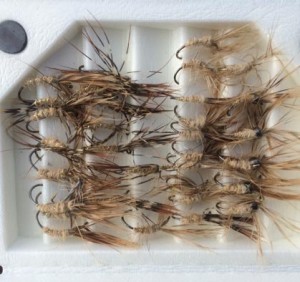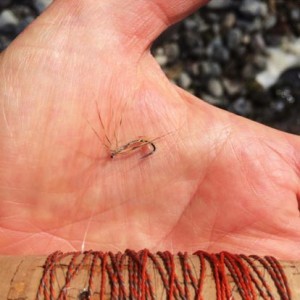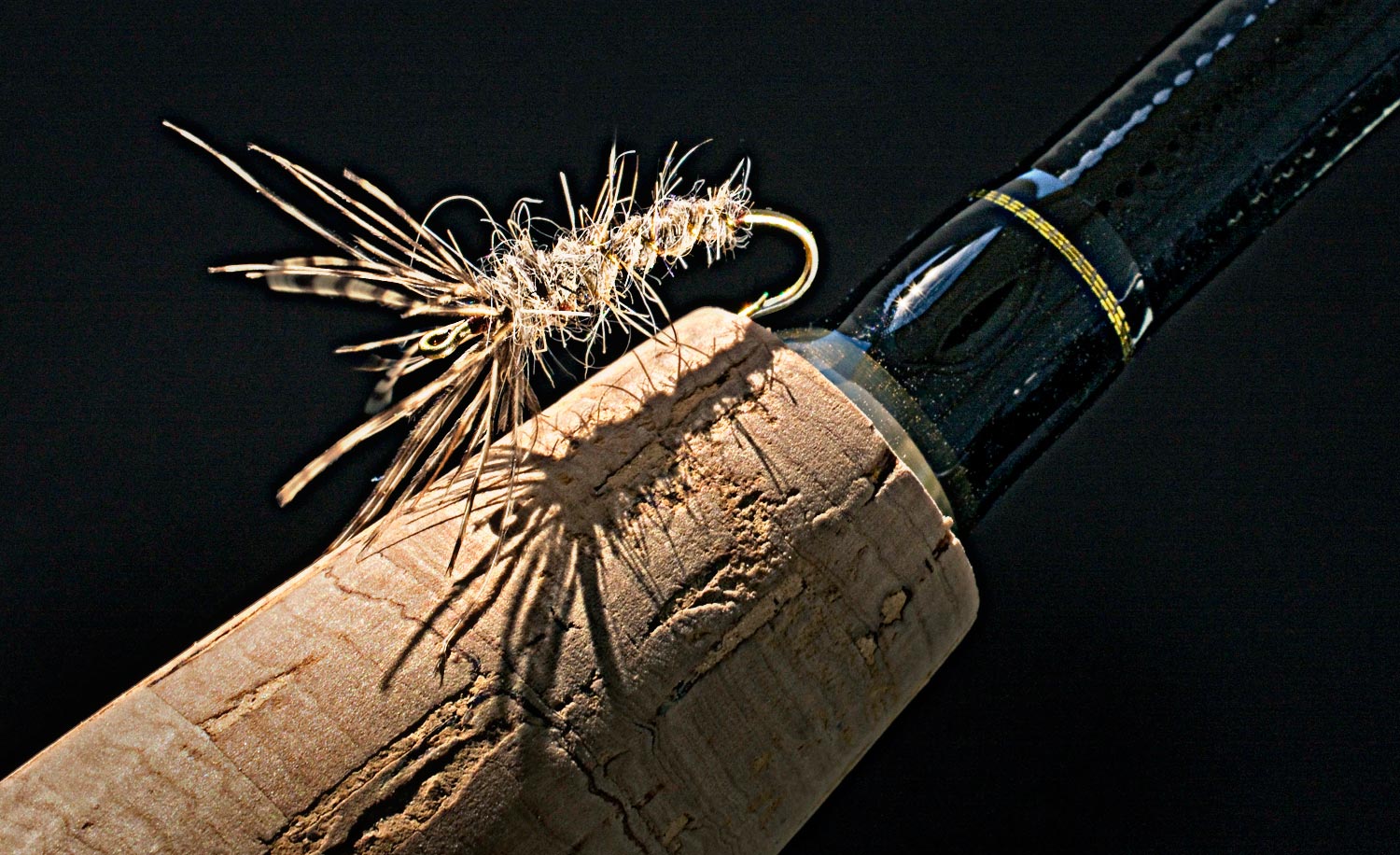By Tim Harris
Last season was a tough one for me.
I spent the year dealing with a chronic illness that would just not clear up and it greatly limited the amount of time I could get out of the house and how much time I could spend on the water. I decided that to make life easier I could only fish local streams that ranged from my backyard, literally, to several others within 10 miles of my house. I also decided that I would only fish tenkara for trout on these streams and to make things even simpler I decided I would stick to one fly throughout the year so I wouldn’t even have to think about that.
Sticking to one fly is part of the philosophy behind tenkara. Tenkara developed out of commercial fishing in Japan and efficiency was important to these fishermen. Anything not necessary was left out of the practice and sticking to one pattern was the best way to simplify selection of pattern and fly tying. It is about the opposite of the Western Match the Hatch philosophy where anglers carry boxes full of patterns designed to imitate a specific species of insect in a specific stage of life. Daniel Galhardo of TenkaraUSA wrote a good piece about the Single Fly Approach for Gink & Gasoline last year and there are several good posts on the TenkaraUSA blog about sticking with one pattern. A few anglers have decided to take this concept beyond tenkara and try to fish an entire season for different fish with one single pattern — Paul Pucket’s experiment using just an Everglades Special comes to mind.
 I only fished a handful of kebari in my first year of tenkara. So, I only needed to narrow it down to one of the patterns I had been using. I opted for one I call the Gold Ribbed Hare’s Ear Sakasa Kebari since the GRHE was one of my favorite nymph patterns and the thing just looked buggy as all heck. I tied up a box of these from #12-#16, some with beads but most without and was ready for the season to open up. I ended up sticking to this one pattern throughout the year, somehow managed to fit in 78 days on the water using it, and I only got skunked one day. I caught cutthroat, rainbows, brookies, browns and the occasional whitefish on it. I caught fish from 3″ long to a whopping 18″ rainbow one day.
I only fished a handful of kebari in my first year of tenkara. So, I only needed to narrow it down to one of the patterns I had been using. I opted for one I call the Gold Ribbed Hare’s Ear Sakasa Kebari since the GRHE was one of my favorite nymph patterns and the thing just looked buggy as all heck. I tied up a box of these from #12-#16, some with beads but most without and was ready for the season to open up. I ended up sticking to this one pattern throughout the year, somehow managed to fit in 78 days on the water using it, and I only got skunked one day. I caught cutthroat, rainbows, brookies, browns and the occasional whitefish on it. I caught fish from 3″ long to a whopping 18″ rainbow one day.
What did I learn from this experience? Several things.
First, I learned that it is the presentation, not the fly that matters the most. If you can get a good presentation the fish will eat the fly. Granted, these are foothill and mountain streams where trout are not keyed in on a hatch for the most part and are more opportunistic. But that is what tenkara was made for, and sticking to one pattern works well in this environment. No matter what the situation was this year I was able to find a presentation method that would get fish to eat the fly. Using my one fly, I was able to catch fish on the surface even when they were rising to smaller insects, swinging, dead drifting, pulsing, and upstream retrieving. If no fish were rising I would often start working up a run by dead drifting mixed with some pulsing. As I got further up I would begin to allow the fly to drift below and swing across the current and then retrieve upstream a bit before moving up and casting again. This way I could cover any fish in the run with multiple techniques and one of them usually would do the trick. Swinging became my favorite at the end of the season but I’m a steelheader at heart and love the grab on a swung fly even if it is by an 8” trout.
 The other thing I learned is that the pattern I chose was probably way more complicated than it needed to be to still be effective. I had days where the fly got shredded and all that was left was a few wraps of thread and a bit of hackle and I still caught fish. To me, the rib adds some flash and the dubbing some bugginess but if they will eat a hook that has a few hackles left then maybe those materials are not that important. This got me to thinking maybe I’d simplify even further this season and forgo the dubbing and rib and fish a tan Amano Sakasa Kebari to see if it does just as well. My guess is that it will and would be much quicker and cheaper to tie.
The other thing I learned is that the pattern I chose was probably way more complicated than it needed to be to still be effective. I had days where the fly got shredded and all that was left was a few wraps of thread and a bit of hackle and I still caught fish. To me, the rib adds some flash and the dubbing some bugginess but if they will eat a hook that has a few hackles left then maybe those materials are not that important. This got me to thinking maybe I’d simplify even further this season and forgo the dubbing and rib and fish a tan Amano Sakasa Kebari to see if it does just as well. My guess is that it will and would be much quicker and cheaper to tie.
Finally I realized that sticking to one fly is a great way to become a better tenkara angler. My first season of fishing tenkara I did well, but last season I caught far more fish than the year before. Not worrying about pattern allows you to experiment with technique instead of switching flies when the fish are not hitting. Nothing working up a run dead drifting, don’t tie on a different fly, just turn around and swing the fly downstream through the run again and see if that gets the fish excited. I feel everyone should give it a try once they have mastered the basics of tenkara because it is the best way to learn all the presentation techniques in the shortest period of time.
Tim Harris Gink & Gasoline www.ginkandgasoline.com hookups@ginkandgasoline.com Sign Up For Our Weekly Newsletter!


Good post!
time to haul out the cane pole and engage in some “redneck tenkara” – from the float tube.
I once knew a guide who used only a Borchers in varying sizes all season, and for years I have wanted to try using a Robert’s Drake from May to September. One of these days, I might get around to it. It certainly seems reasonable, because you can use these dries as they are meant to be fished, on top, or you can swing them in the film, or even sink them and twitch like slow moving nymphs.
It is a definite must try; finding the right fly might be the issue. Too many flies to choose from.
Great post! It took some time for me to become confident in the one fly approach. Now I fish a pheasant tail kebari in size 14 I have been consistently catching fish in all size of water. I think that confidence more than the fly is the big ticket.
Great post. We follow your posts regularly and enjoy the true passion for fishing you express. We find it entertaining how much time anglers spend tying and retying just wondering which bug the fish are eating while we catch fish and watch the others tie again.
Sorry to hear you were experiencing health problems. Two of us at CurrentSeamsFlyFishing are actually nurses so we hope the best for you. Health problems can really change perspective. Best of luck to you. Keep up the great work. Your friends at CSFF.
Pingback: Tippets: Year of One Fly, Art of Fly Fishing, Teaching Teens | MidCurrent